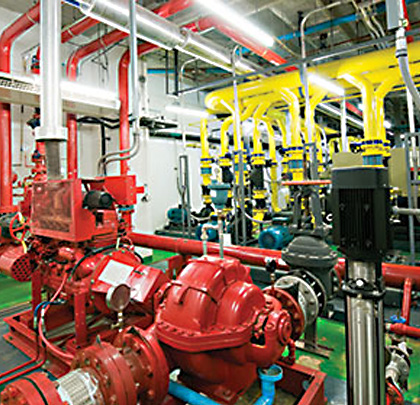In viewing installations across the country we’ve seen centrifugal pump systems function without the benefit of any valves except for the necessity of a system maintenance shut off valve downstream of the pump, this causing a dead head condition for the pump whenever the valve is actuated. It has been interesting to observe the number of pumps needing service with obvious bad bearings, shaking and rattling throughout the entire system. In addition we have been to multiple facilities where the norm, in a population of 150 to 200 various centrifugal pumps, is the need for fifteen to twenty pump replacements per month.

EXTENDING LIFE, REDUCING DOWN TIME
Engineering a system for maximum life and minimal down time will always include valves to optimize the system and give the clear benefits of reducing pump maintenance and/or replacement and maximizing system efficiencies.
During the installation of any centrifugal or high flow, high head pressure pumps there are inefficiencies and maintenance issues introduced to the system impacting pump life and system reliability. Inefficiencies in fluid dynamics are primarily due to friction and associated temperature increases, fluid viscosity, using the pump outside of its optimal RPM, system idiosyncrasies and system design flaws as well as operator errors in deadheading or running the pump dry.
All of the same factors contribute greatly to premature pump failure. The system design Engineer can positively affect the efficiencies thereby affecting pump cost of ownership by increasing MTBF (mean time between product failure) via correct piping installation and by utilizing optimally sized valves with high accuracy and high flow capacity.
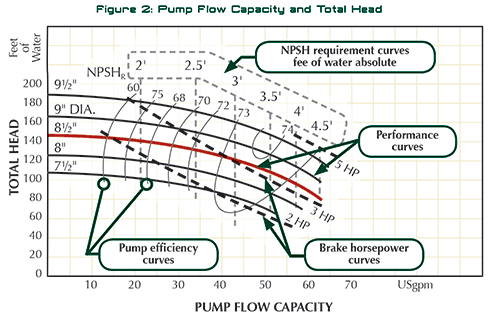
The effect of utilizing correct and properly sized valves cannot be over emphasized as the lack thereof will cause piping systems and pumps to fail prematurely negatively affecting MTBF and also dramatically impacting the efficiencies of the pump increasing the power consumption of the pump and the related cost of ownership.
The MTBF is dependent upon multiple factors and can be enhanced to typically double the life span of a pumps normal yearlong warranty by including pump maintenance (i.e., preventive maintenance schedule for lubrication) as well as procedures that will eliminate the dead heading of pumps.

VALVE SELECTION CRITERIA / PUMP OPTIMIZATION
Other than the obvious inclusion of bypass valves to minimize the risk associated with dead heading the pump (see bypass valve selection criteria), valves can also be selected which can optimize the pump RPM and, depending on the valve capacity and performance (i.e., maximizing flow upon pressure rise) can compensate for system design flaws.
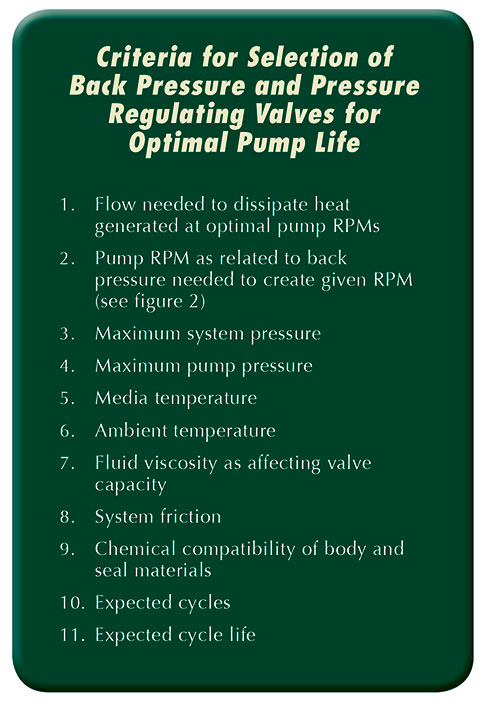
Installing a back pressure valve immediately downstream of the pump set at the optimum pump back pressure will keep the pump in its optimum range minimizing the risk of running outside of its optimal RPM range. A pump is typically run within an RPM range which in addition to maximizing its efficiency on its “pump curve,” also allows for keeping its RPM where heat dissipation is maximized—thereby reducing wear on rotational bearings and seals and again extending MTBF while also maximizing pump efficiencies. The more accurate the valve is at maintaining a specific set pressure at varying flow conditions the more consistency of operation of the pump at its optimal RPM (see figure 2).

These clearly show the difference in flow capacity and the potential for friction loss through the valves thereby affecting the RPM needed from your variable frequency drive pumps to achieve pressures necessary to move fluid throughout the system.
The higher the flow capacity of the valves the more efficient the system and the lower the cost of ownership for both valves and piping system based on lowering the cost of fluid transfer (see figure 4).

A needed increase of 10 percent at 50 percent of maximum flow can increase the pumps power consumption by as much as 59 percent dramatically affecting the cost of operation (see figure 5).
Due to increased efficiencies and energy savings VFD (variable frequency drive) pumps have been favored over standard centrifugal pumps but any increase in flow needed downstream inclusive of the needed head pressure increases to overcome restrictions in valves will cause a significant increase in energy usage and thereby have a significant cost associated with their flow restriction. These inherent costs to overcome restrictions in valve capacity more than justify installation of higher throughput valves as needed to increase system efficiencies.

PUMP ENERGY USE AS RELATED TO COST OF OTHER MOTORS
Pumps, especially multi-horsepower pumps, are some of the highest energy consumers in process operations. A study by the U.S. Department of Energy confirmed that pumps consume about 50 percent of the energy used in a plant (see figure 6).

Increasing the efficiency of the pumps via the correct selection of the pump as well as related valve components can dramatically impact operational costs. Correct valve selection can contribute to dramatic savings by increasing system efficiencies and reducing the speed of the VFD pumps.
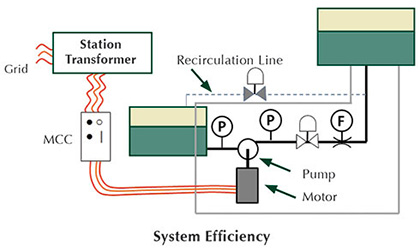
The flow given is the flow between tanks. The head is the elevation difference without the inclusion of friction caused by length and diameter of pipes as well as any elbow etc. This is system efficiency without the details (which should and would be included in any true design effort). This approach can give a general and basic starting point for system configuration. As an example a recirculation system without any static head (no elevation change of the fluid will give zero system.
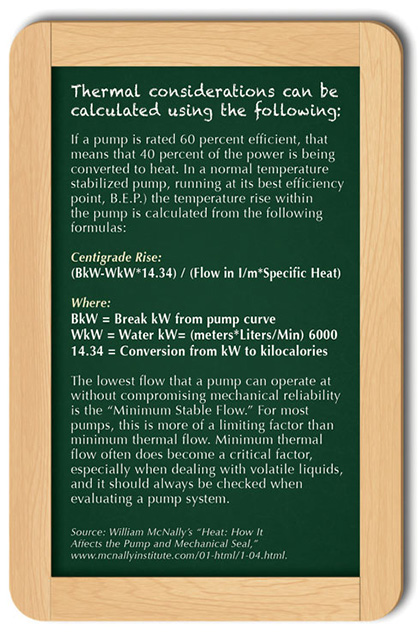
A FINAL WORD ON EXTENDING MTBF
Obvious from the comparing of bypass, backpressure, and regulator valve selection criteria are the commonalities associated with all and the importance of considering multiple factors for the correct selection to enhance system functionality as well as extend pump MTBF.
Savings potential from optimizing pump curves can have both an immediate effect of reducing pump maintenance and pump replacement cost as well as the long term energy savings obtained by maximizing the efficiency of the pump.

The best, most efficient results with longest MTBF will occur by consulting professionals who evaluate your system requirements with respect to the selection of both pumps and valves considering all of the various influencing factors in particular flow and the significant energy usage impact of flow restrictions. ■
_________________________________________________________________________
ABOUT THE AUTHOR
Ed Cellucci is the national sales manager for Plast-O-Matic Valves, Inc. of Cedar Grove, New Jersey. For more information, visit www.plastomatic.com.
_________________________________________________________________________
MODERN PUMPING TODAY, June 2013
Did you enjoy this article?
Subscribe to the FREE Digital Edition of Modern Pumping Today Magazine!
![]()


